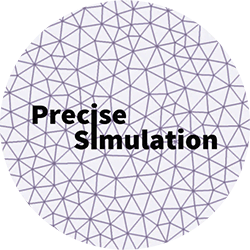
|
FEATool Multiphysics
v1.17.5
Finite Element Analysis Toolbox
|

|
FEATool Multiphysics
v1.17.5
Finite Element Analysis Toolbox
|
EX_SCHRODINGER1 Schrodinger equation for the Hydrogen atom.
[ FEA, OUT ] = EX_SCHRODINGER1( VARARGIN ) Computation of energy levels and electron orbits for a 1-particle Hydrogen atom system using the Schrodinger equation in cylindrical coordiantes. Accepts the following property/value pairs.
Input Value/{Default} Description
-----------------------------------------------------------------------------------
hmax scalar {0.1} Grid cell size (in meter scale)
sfun string {sflag2} Finite element shape function
iphys scalar 0/{1} Use physics mode to define problem (=1)
or directly define fea.eqn/bdr fields (=0)
or use core assembly functions (<0)
iplot scalar 0/{1} Plot solution (=1)
.
Output Value/(Size) Description
-----------------------------------------------------------------------------------
fea struct Problem definition struct
out struct Output struct
cOptDef = { 'hmax', 0.05;
'sfun', 'sflag2';
'iplot', true;
'tol', 0.02;
'fid', 1 };
[got,opt] = parseopt(cOptDef,varargin{:});
fid = opt.fid;
% Geometry definition (in meters).
fea.sdim = {'r', 'z'};
fea.geom.objects = { gobj_circle([0,0], 3, 'C1'), ...
gobj_circle([0,0], 0.5, 'C2'), ...
gobj_rectangle(-3, 0, -3, 3, 'R1'), ...
gobj_rectangle(-3, 0, -3, 3, 'R2')};
fea = geom_apply_formula( fea, 'C1-R1' );
fea = geom_apply_formula( fea, 'C2-R2' );
% Grid generation.
fea.grid = gridgen( fea, 'hmax', opt.hmax, 'fid', fid );
% Scale geometry and grid to nanometer scale.
s = 1e-9;
fea = geom_apply_transformation( fea, fea.geom.tags, 0, s );
fea.grid.p = fea.grid.p * s;
% Constants and expressions.
me = 9.10939e-31; % Electron mass.
ec = 1.6021773e-19; % Electron charge.
hp = 6.626076e-34; % Planck's constant.
e0 = 8.8541878e-12; % Electric capacitivity in vacuum.
m = 0; % Ground state energy.
fea.expr = { 'me', me;
'e', ec;
'hp', hp;
'e0', e0;
'C', '8*me*pi^2/hp^2';
'm', m};
% Problem definition.
fea = addphys(fea,@poisson); % Add Poisson equation physics mode.
fea.phys.poi.sfun = { opt.sfun }; % Set FEM shape function.
fea.phys.poi.eqn.seqn = ...
'C*r*u'' - r*(ur_r+uz_z) = 1+(C*r*e^2/(4*pi*e0*sqrt(r^2+z^2))-m^2/r)*u_t';
% fea.phys.poi.eqn.coef{1,end} = { 'C*r' }; % Set time coefficient.
% fea.phys.poi.eqn.coef{2,end} = { 'r' }; % Set diffusion coefficient.
% fea.phys.poi.eqn.coef{3,end} = { '1+(C*r*e^2/(4*pi*e0*sqrt(r^2+z^2))-m^2/r)*u' }; % Define source term coefficient.
% Define boundary conditions (Homogenous Neumann on symmetry axis, and Dirichlet on sphere boundary.)
fea.phys.poi.bdr.sel = [1 1 2 2 2];
% Parse and solve problem.
fea = parsephys(fea);
fea = parseprob(fea);
[fea.sol.u, fea.sol.l] = solveeig( fea, 'sigma', -2.18e-18, ...
'neigs', 10, 'fid', fid );
% Error checking.
lam = [-2.18e-18; -5.45e-19; -5.45e-19; -2.422e-19; -2.422e-19];
out.err = abs((lam - fea.sol.l(1:5))./lam);
out.pass = all(out.err < opt.tol);
% Postprocessing.
if( opt.iplot>0 )
isol = 5;
postplot( fea, 'surfexpr', 'u', 'solnum', isol )
title(sprintf('u(lambda(%d)) = %g', isol, fea.sol.l(isol)))
end
if( nargout==0 )
clear fea out
end